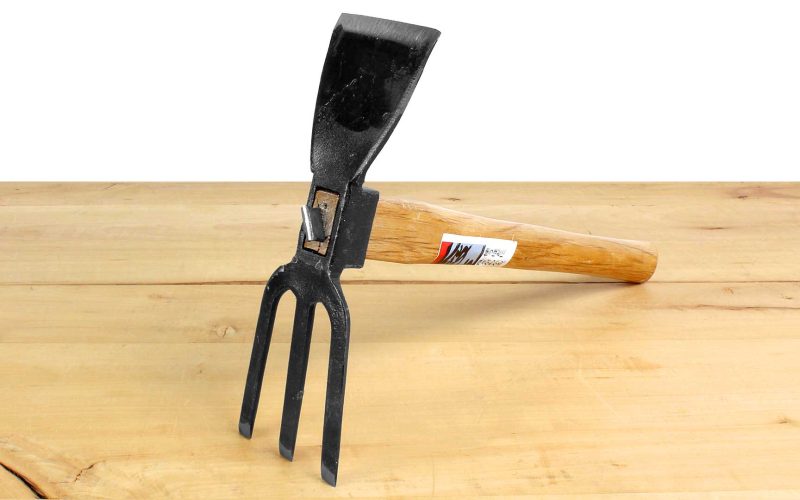If you’re new to gardening, you may not be aware of the various types of garden hoes available and how they can make your gardening tasks easier.
Here, we will explore the different types of garden hoes, their uses, and which type is best suited for specific gardening tasks.
Understanding the different types of garden hoes can help you make the most of your gardening experience. Follow along!
1. Draw Hoe
The draw hoe is one of the most traditional and versatile gardening tools.
It is characterized by its flat, rectangular blade set at a right angle to a long handle and is a staple in many gardens.
The blade typically measures 6 to 8 inches wide, providing a broad surface area perfect for various tasks.
This hoe’s primary function is to break up compacted soil, making it easier to work with and more conducive to plant growth.
It effectively digs trenches by chopping into the ground and drawing the soil towards the gardener.
This helps plant seeds or bulbs at the correct depth and spacing.
The draw hoe also excels in shaping the soil into mounds or rows, a technique often used in vegetable gardening to create raised beds or furrows.
This method helps with irrigation and promotes better air circulation around the plants, leading to healthier growth.
The long handle of the drawhoe allows for a comfortable working posture, reducing the strain on the gardener’s back and arms.
This tool’s simplicity and effectiveness make it an indispensable part of any gardener’s toolkit. It is suitable for both novice and experienced gardeners.
2. Dutch Hoe
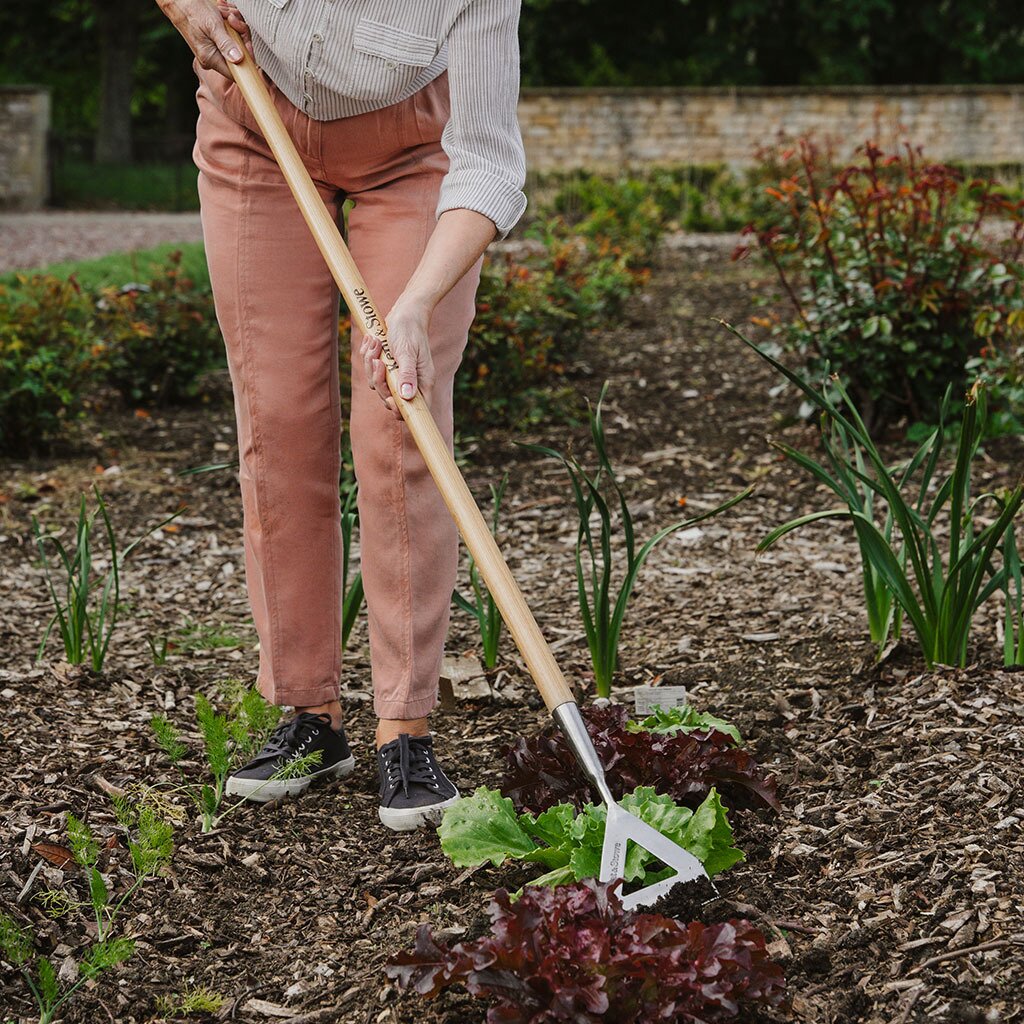
The Dutch hoe, also known as a push hoe, is among the various garden hoes.
It features a flat, triangular, or heart-shaped blade parallel to the handle.
The blade’s shape allows it to slice through soil beneath the surface.
Unlike traditional hoes used with a chopping motion, the Dutch hoe is designed for a pushing or sliding action.
This makes it more ergonomic and less strenuous to use over long periods.
The blade is often sharpened on both edges, which increases its efficiency in cutting weeds.
The primary use of the Dutch hoe is for weeding. Its design makes it exceptionally good at cutting through the roots of weeds just below the soil surface, preventing them from regrowing.
This makes it an ideal tool for maintaining weed-free garden beds without disturbing nearby plants’ soil structure or roots.
Besides, the Dutch hoe is particularly effective in loose, sandy, or loamy soils where the sliding motion can be performed smoothly.
You can use it to break up the top crust of the soil, which can help improve aeration and water penetration.
Because of its design, the Dutch hoe allows gardeners to weed while standing upright, reducing back strain and making garden maintenance more comfortable.
3. Stirrup Hoe (Scuffle Hoe)
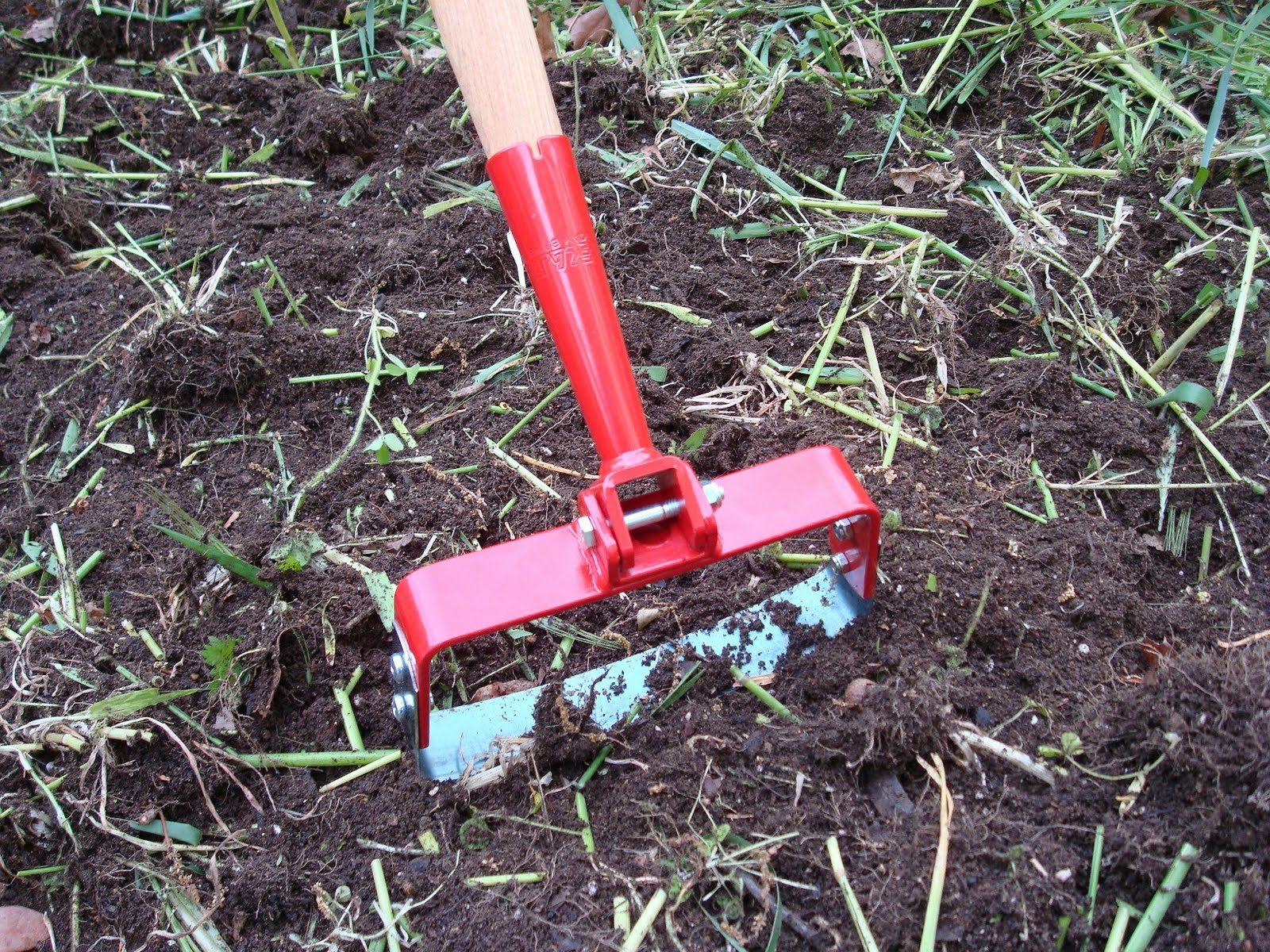
The stirrup hoe, also known as the scuffle hoe, is a versatile and highly efficient tool favored by gardeners for its unique design and functionality.
Its distinctive feature is a stirrup-shaped, or looped, blade that rocks back and forth.
This motion enables the blade to cut weeds on the push and pull strokes.
Thus, it’s highly effective for clearing weeds quickly and with less effort than traditional hoes.
The stirrup hoe’s blade typically has sharpened edges on both sides, which enhances its ability to slice through soil and weeds seamlessly.
This dual-action cutting significantly reduces the physical strain on the user, allowing for extended periods of work without excessive fatigue.
The blade’s rocking motion helps maintain a constant depth, ensuring that weeds are cut just below the soil surface without disturbing the roots of nearby plants.
One of the stirrup hoe’s primary advantages is its efficiency in covering large areas swiftly.
This makes it particularly useful for gardeners with expansive plots or those managing vegetable beds.
Its design also minimizes soil disruption, preserving soil structure and moisture.
Besides, the stirrup hoe can navigate around established plants, making it an excellent choice for weeding in densely planted areas without damaging the crops.
4. Warren Hoe (Diamond Hoe)
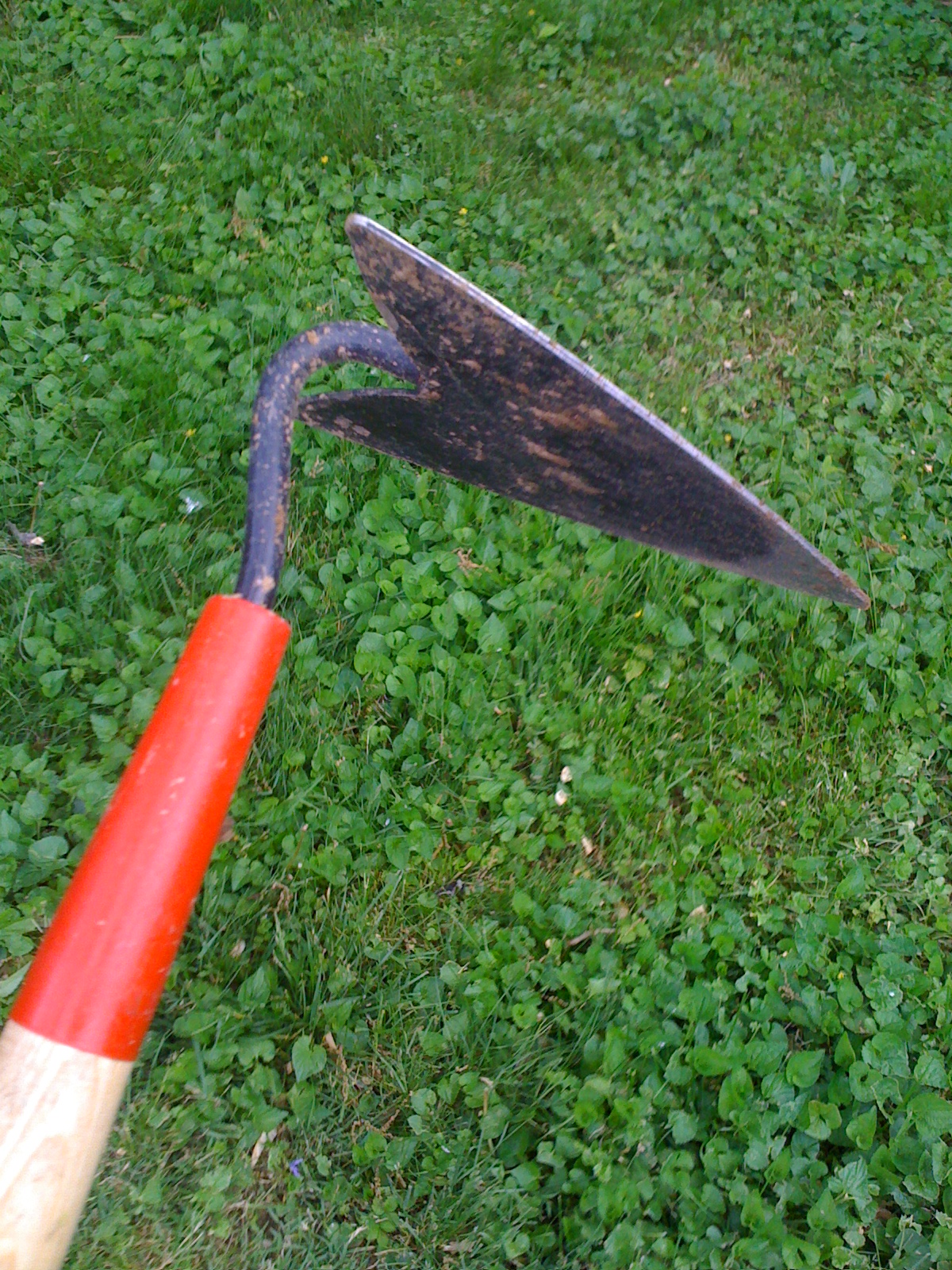
Next on our list of different types of garden hoes is the Warren Hoe.
Also known as the diamond hoe, it is distinguished by its diamond-shaped blade with sharp edges.
This unique shape allows for versatile and precise gardening tasks.
The diamond blade’s pointed ends make it particularly effective for reaching tight spaces and intricate areas around plants.
Gardeners often favor the Warren Hoe for its ability to perform delicate weeding without disturbing the roots of nearby plants.
Aside from weeding, the Warren Hoe is excellent for breaking up compacted soil and aerating the ground, ensuring that plant roots receive adequate air and nutrients.
The blade’s sharp edges can cut through tough soil and even small roots, making it a valuable tool for preparing garden beds and planting seeds.
Its lightweight design and ergonomic handle allow for extended use without causing excessive strain on the gardener’s hands or back.
The Warren Hoe’s versatility extends to tasks like trenching for irrigation or planting, thanks to its ability to create clean, narrow furrows.
5. Collinear Hoe
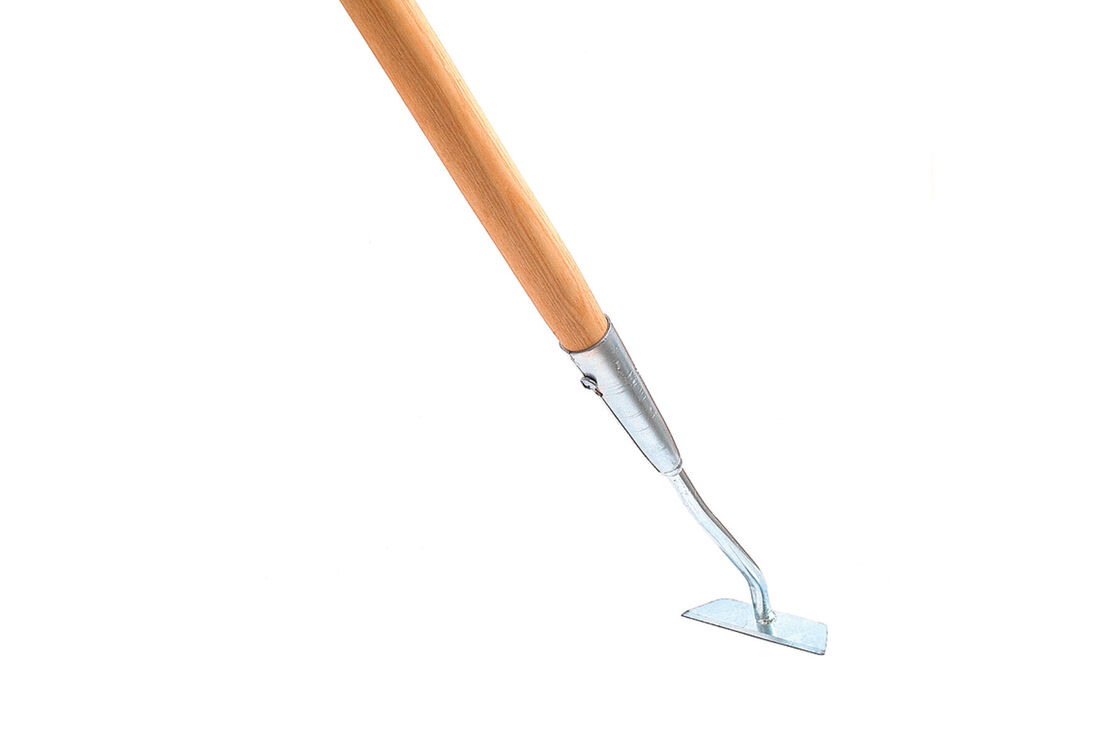
The collinear hoe has a narrow, rectangular blade that aligns parallel to the handle.
This design works for slicing weeds in thin, densely planted rows without disturbing the surrounding plants.
The long, slender blade allows gardeners to reach into tight spaces and work precisely, making it an ideal tool for maintaining vegetable gardens and flower beds where plants are closely spaced.
One of the primary advantages of collinear hoe is its weeding efficiency.
The sharp, flat blade slices through weeds below the soil surface, severing their roots and preventing regrowth.
This method is less disruptive to the soil structure than traditional hoeing, which can uproot plants and disturb the soil.
The Collinear Hoe’s lightweight design and ergonomic handle make it easy to maneuver and reduce fatigue during prolonged use.
Beyond weeding, the Collinear Hoe is useful for light cultivation and soil aeration.
It can gently loosen the top layer of soil, improving water infiltration and promoting healthy root growth.
Its precise action makes it suitable for creating shallow trenches for seed planting and small-scale garden maintenance tasks.
6. Onion Hoe
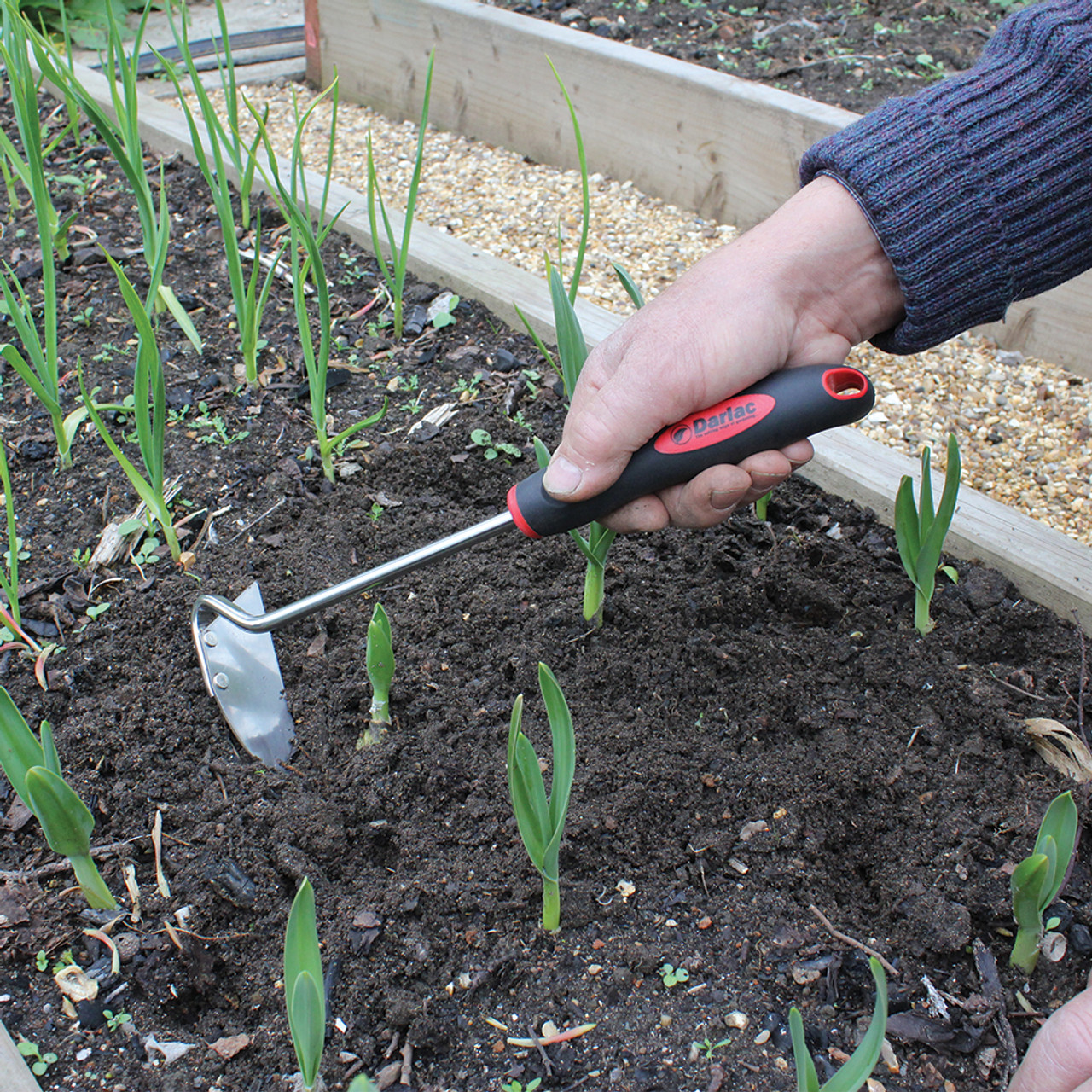
The onion hoe works in closely planted rows of onions or similar crops.
Its narrow blade allows for precise weeding and cultivation in tight spaces without damaging the delicate plants.
The long handle provides reach and leverage, enabling the gardener to work efficiently and comfortably.
This hoe excels in tasks that require meticulous attention to detail.
The narrow blade can easily maneuver between plants, slicing weeds at the root level and preventing their regrowth.
This targeted approach minimizes soil disturbance, preserving the integrity of your crops’ root systems.
The onion hoe is also useful for breaking up compacted soil, enhancing aeration, and promoting healthy root development.
Besides weeding, the onion hoe can be employed for light tilling and soil preparation.
Its compact size makes it ideal for creating narrow furrows for seed planting or hilling soil around growing plants to support their stems.
The handle’s ergonomic design ensures that gardeners can use the hoe for extended periods without experiencing undue fatigue or strain.
7. Pointed Hoe
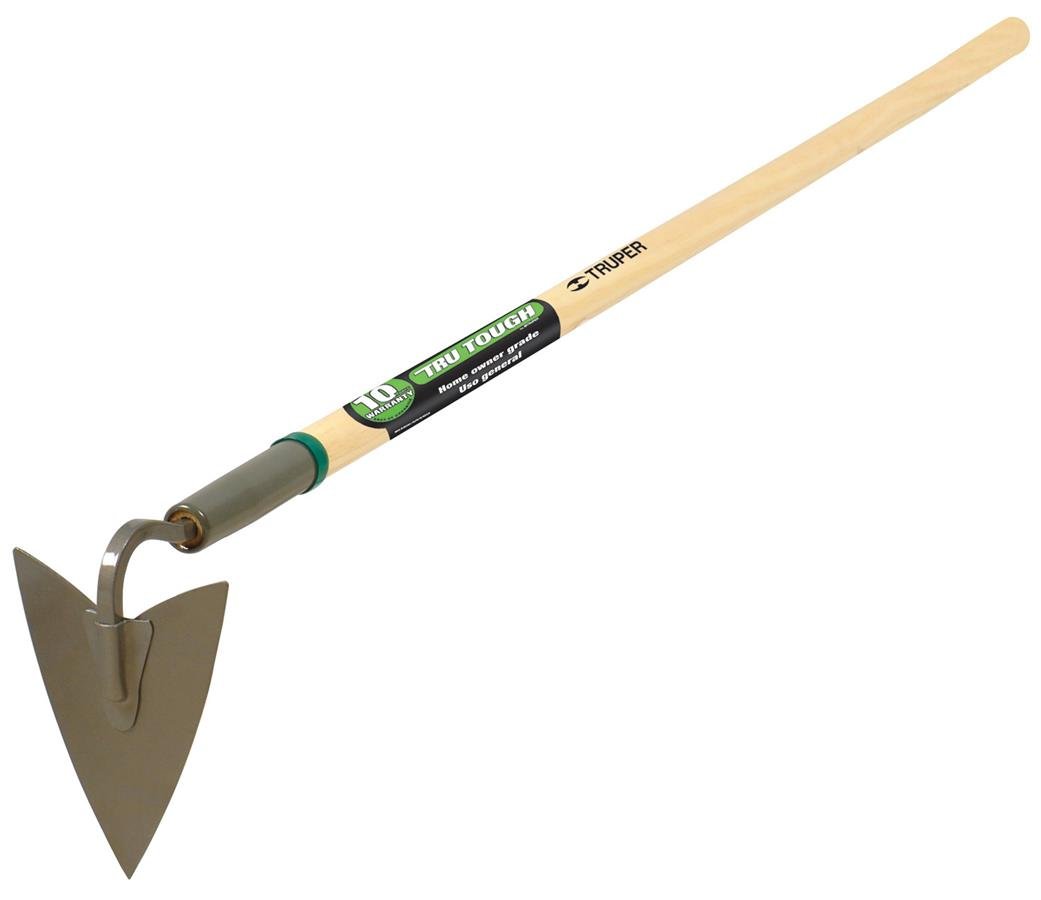
Another type of garden hoe is the pointed hoe. Often featuring a heart-shaped or triangular blade, it is a versatile gardening tool designed for various tasks.
The pointed blade allows for precise digging, making it ideal for planting seedlings, bulbs, and small plants.
The sharp point can easily penetrate hard or compacted soil, creating holes and furrows with minimal effort.
This hoe is particularly effective for tasks that require precision and control.
The pointed blade can dig small holes for transplanting, ensuring plants are placed at the correct depth and spacing.
It is also excellent for weeding, especially when weeds grow near desirable plants.
The pointed tip can reach the base of weeds, slicing through their roots and preventing regrowth without disturbing surrounding plants.
The Pointed Hoe is also useful for creating furrows for seed planting.
Its shape allows for clean, narrow trenches, perfect for sowing rows of seeds.
The pointed blade can aerate the soil, improve drainage, and promote root health.
The ergonomic handle provides comfort and leverage, allowing gardeners to work efficiently without excessive strain.
8. Wheel Hoe
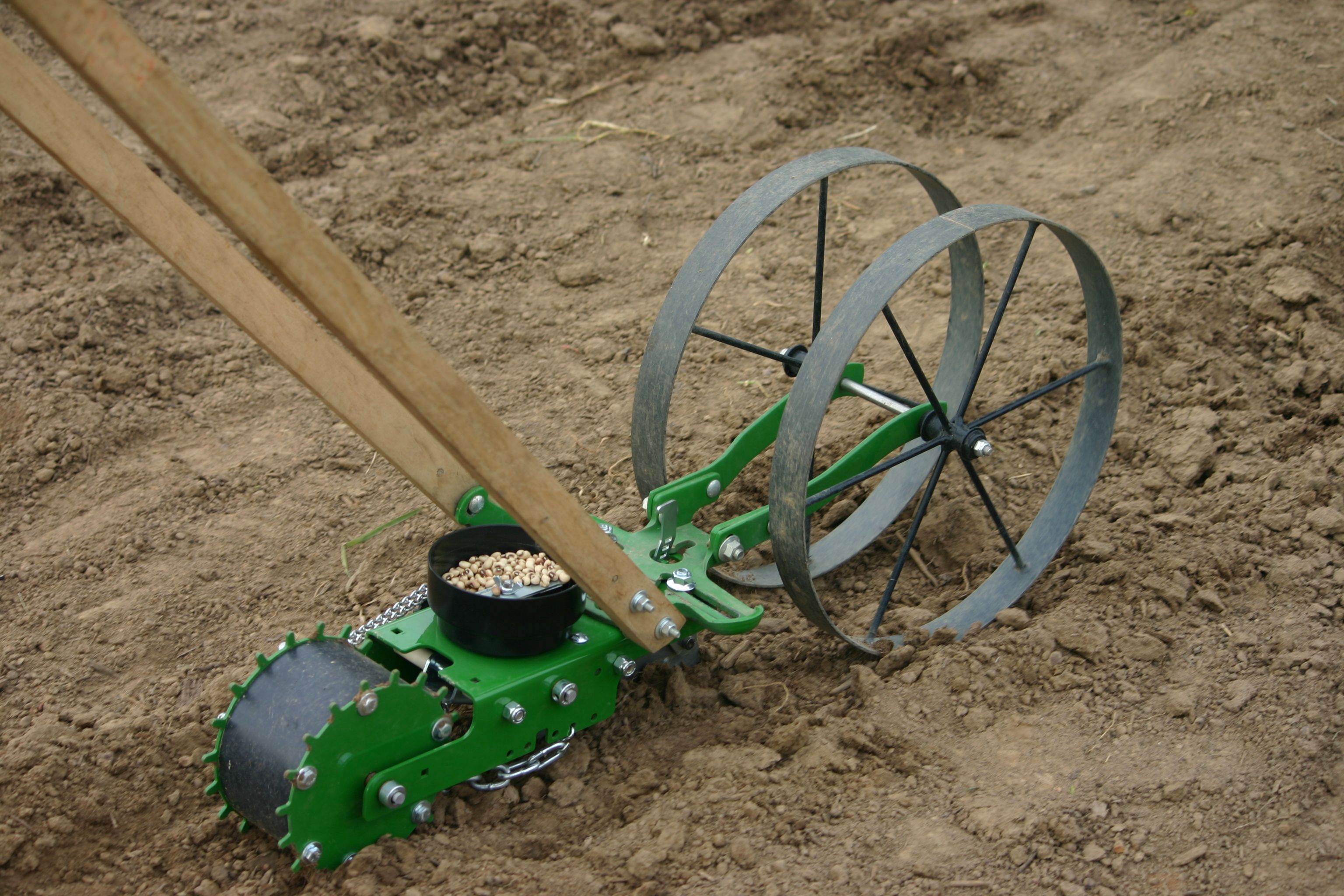
The wheel hoe is a unique gardening tool that combines a hoe with a wheel, often equipped with interchangeable attachments.
This design allows for efficiently cultivating large garden areas with minimal physical strain.
The wheel provides stability and ease of movement, enabling gardeners to cover more ground quickly and with less effort than traditional hand hoes.
One of the wheelhoe’s primary advantages is its versatility. Attachments can include various types of blades, plows, and cultivators.
The ability to swap out attachments means that a single Wheel Hoe can perform the functions of several different tools.
This reduces the need for multiple implements and saves storage space.
The wheel hoe’s ergonomic design allows gardeners to work upright, reducing the risk of back and joint strain.
The wheel mechanism ensures smooth and steady movement, which is especially beneficial for those with larger garden plots.
The tool’s efficiency and ease of use make it ideal for organic gardening.
It effectively controls weeds mechanically, reducing the need for chemical herbicides.
9. Flat Hoe

The flat hoe features a wide, flat blade that can be rectangular or trapezoidal.
This design makes it a versatile tool for general garden maintenance tasks such as weeding, soil leveling, and shaping beds.
The broad blade allows for efficient weed removal, as it can cover a larger area with each stroke than narrower hoes.
One of the flat hoe’s key benefits is its ability to level soil. After tilling or turning the soil, the flat hoe can smooth out the surface, creating an even and level bed for planting.
This is particularly important for ensuring consistent seed depth and improving water distribution in the soil.
The wide blade can also shape garden beds and create raised rows, enhancing drainage and root development for many plants.
In addition to weeding and soil leveling, the flat hoe is useful for breaking up crusted soil surfaces, which can improve aeration and water infiltration.
The broad, flat blade can gently break up the top layer of soil without disturbing deeper layers.
Further, the flat hoe’s ergonomic handle provides comfort and control, allowing gardeners to work for extended periods without excessive fatigue.
10. Triangular Hoe
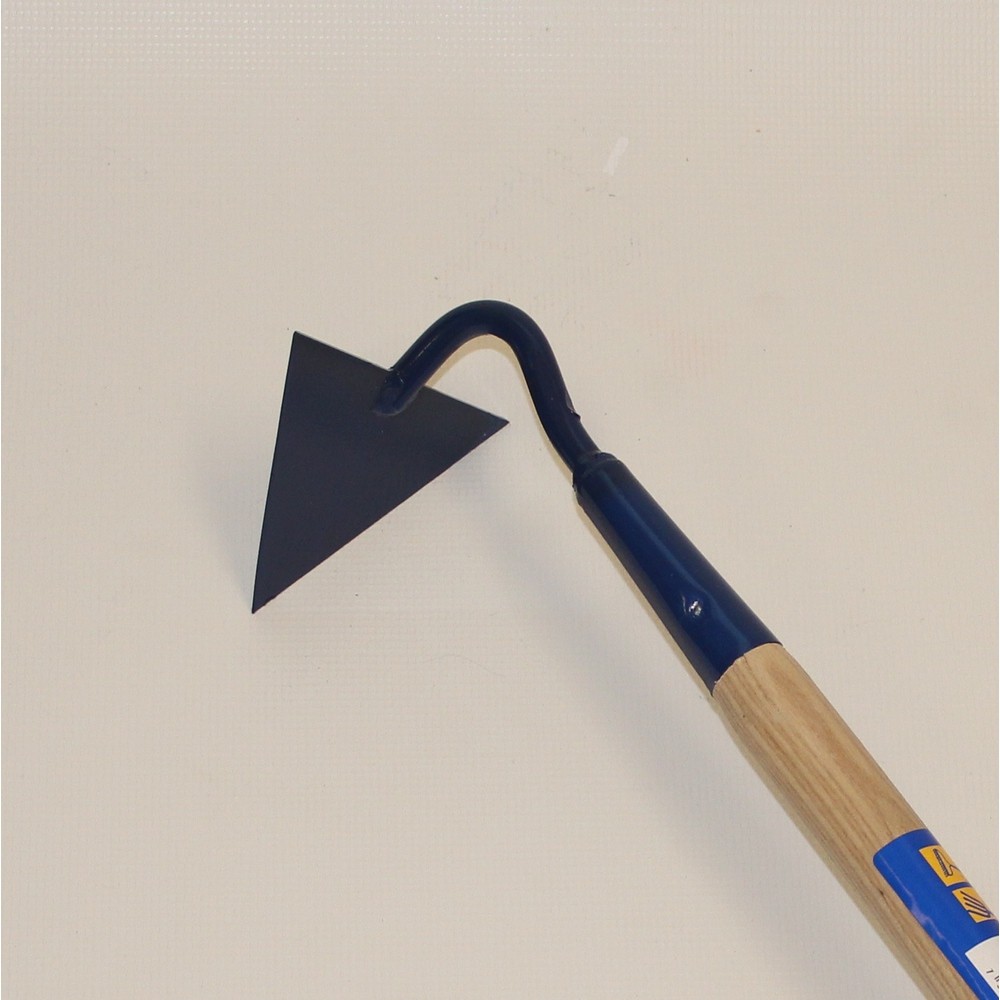
The triangular hoe is one of the different types of garden hoes. It is characterized by its triangular blade, often with a pointed tip and sharp edges.
This design makes it particularly effective for breaking up soil and aerating the ground.
The pointed tip allows for precision work, while the sharp edges can easily cut through roots and tough soil.
This hoe is ideal for working between closely spaced plants and making furrows for planting seeds.
The pointed tip can create narrow trenches, ensuring seeds are sown at the correct depth and spacing.
The sharp edges of the triangular blade are also useful for slicing through weeds and roots, making it a versatile tool for weeding and soil preparation.
Besides, the triangular hoe is effective for hilling soil around plants.
The pointed blade can pull soil up around the base of plants, supporting stems and improving water retention.
This benefits crops like potatoes, where hilling can enhance growth and yield.
The ergonomic handle ensures comfort and control, allowing gardeners to work efficiently without excessive strain.
11. Ridging Hoe

The ridge hoe features a curved blade that shapes soil into ridges or raised beds.
This tool is essential for gardeners who practice ridge planting, a technique that involves creating raised rows of soil to improve drainage and root aeration.
One primary use of the ridge hoe is to form raised beds. The wide, curved blade efficiently moves large amounts of soil, allowing gardeners to create uniform ridges with minimal effort.
Raised beds benefit many crops, improving drainage, preventing waterlogging, and enhancing root development.
The Ridging Hoe can maintain these beds’ shape and structure throughout the growing season.
In addition to bed formation, the ridging hoe is useful for hilling soil around plants.
This practice can support stems, improve water retention, and protect roots from temperature extremes.
The wide blade easily pulls soil up around the base of plants, creating a protective mound that promotes healthy growth.
The ergonomic handle of the ridging hoe provides comfort and leverage, allowing gardeners to work efficiently without excessive strain.
12. Mortar Hoe

The mortar hoe, originally designed for mixing mortar, features a unique blade with holes that allow for thoroughly mixing materials.
This design makes it an excellent tool for gardeners who need to mix soil amendments, compost, or other materials into their garden beds.
One of the mortar hoe’s primary advantages is its ability to mix materials evenly.
The holes in the blade help break up clumps and ensure amendments are thoroughly incorporated into the soil.
This is particularly useful for preparing garden beds with compost, fertilizer, or other soil conditioners, ensuring that plants receive the nutrients they need for healthy growth.
In addition to mixing, the mortar hoe can be used for general gardening tasks such as breaking up compacted soil and aerating the ground.
The sturdy blade can penetrate tough soil, making it easier to prepare beds for planting.
The hoe’s design also allows for efficient weeding, as the holes can help to capture and remove weed roots from the soil.
13. Rogue Hoe

The rogue hoe is a heavy-duty gardening tool with a thick, sharpened blade designed for tough jobs like clearing overgrown areas and cutting through thick roots.
Its robust construction makes it ideal for tasks that require significant force and durability.
One of the primary uses of the Rogue Hoe is clearing land and removing stubborn vegetation.
The sharp, heavy blade can easily cut through thick roots and dense undergrowth, making it an excellent tool for preparing new garden plots or reclaiming overgrown areas.
The blade’s durable construction ensures it can withstand heavy use and tough conditions without bending or breaking.
The Rogue Hoe is useful for clearing, breaking up compacted soil, and aerating the ground.
Its thick blade can penetrate hard soil, making it easier to prepare beds for planting.
The hoe’s design also allows for efficient digging and trenching, making it a versatile tool for various gardening tasks.
The ergonomic handle of the rogue hoe provides comfort and leverage, allowing gardeners to work efficiently without excessive strain.
14. Garden Knife Hoe
The garden knife hoe is last on our list of the different types of garden hoes.
It combines a hoe with a knife-like edge on one side, providing a versatile tool for slicing through weeds and precision tasks in tight spots.
This unique design makes the garden knife hoe an excellent choice for gardeners who need a multi-functional tool for various tasks.
One of the primary uses of the garden knife hoe is weeding. The knife-like edge easily slices through weeds at the root level, preventing regrowth and minimizing soil disturbance.
This precision allows gardeners to remove weeds from closely spaced plants without damaging the desired crops.
The hoe side of the tool can then be used to smooth and level the soil, making it a versatile tool for maintaining garden beds.
In addition to weeding, the garden knife hoe is useful for planting and soil preparation.
The sharp edge can be used to create furrows for seed planting, while the hoe side can be used to cover the seeds and level the soil.
The tool’s design also makes it effective for hilling soil around plants, providing support, and improving water retention.




